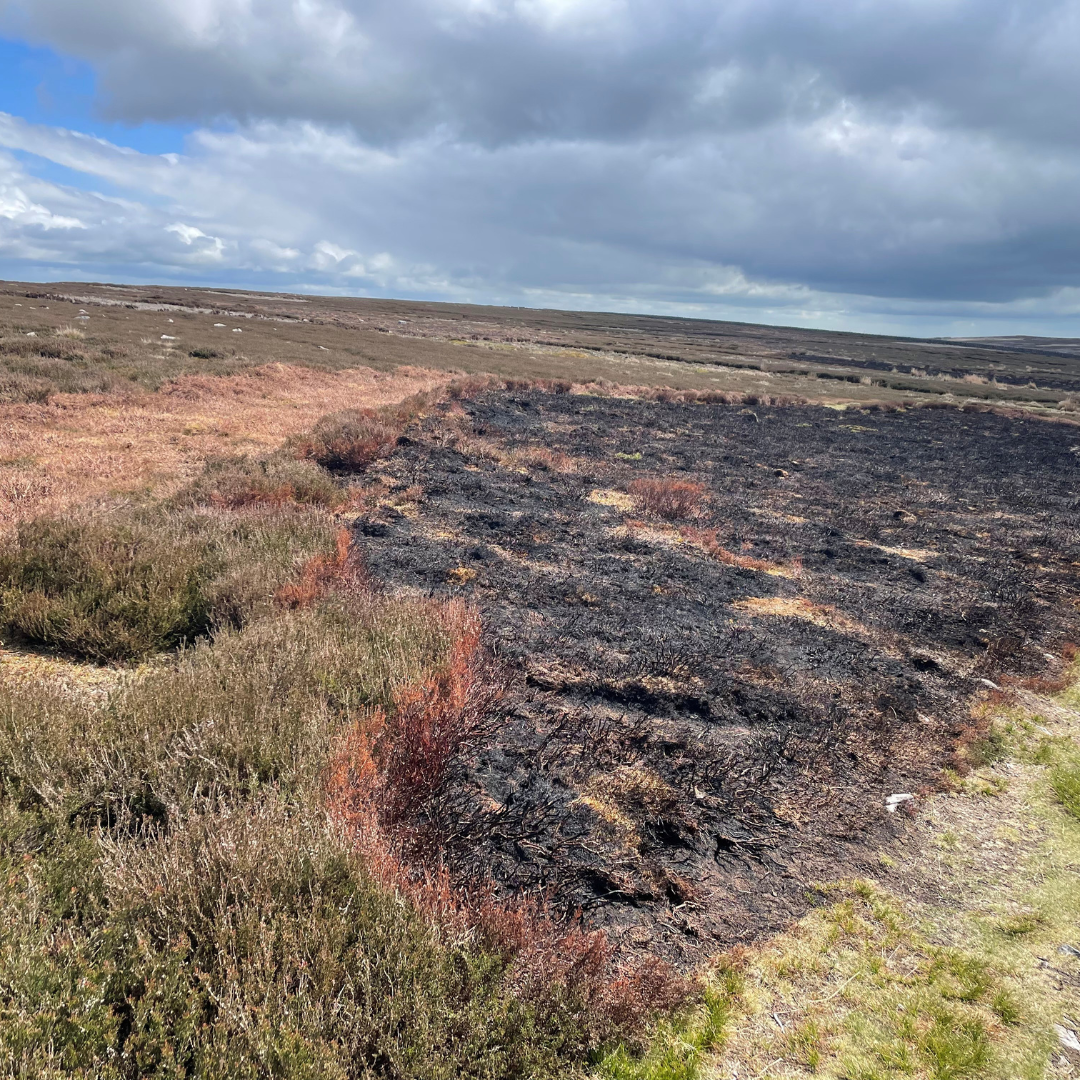
Wildfires and Biodiversity in the UK’s Uplands
With rainfall scarce this spring and upland soils already drying out, wildfire risk is becoming an urgent concern across the UK. As summer approaches, how we manage moorlands, whether through traditional grouse shooting practices or natural moorland restoration, has never been more relevant.
Few topics spark as much debate as moorland management in the UK's upland landscapes, particularly the contrast between areas managed for driven grouse shooting and those following a path of natural moorland restoration. At the heart of this discussion lies a tension between conservation, land use, rural culture and environmental risks, especially concerning wildfire resilience, biodiversity, and community livelihoods.
So, what exactly are the differences between these approaches and how do they compare in terms of ecological health, wildfire risk, and opportunities for people living and working in the uplands?
What are the differences between grouse-managed moors and natural moorland restoration?
Grouse-managed moors are upland areas deliberately maintained for driven red grouse shooting. Landowners apply techniques like controlled heather burning (muirburn), predator control, and selective vegetation management to enhance grouse populations and maintain open moorland habitats. This model is closely tied to rural traditions, game shooting economics, and seasonal employment.
In contrast, natural moorland restoration, often associated with rewilding or low-intervention conservation, is guided by ecological processes rather than intensive human control. Here, burning and predator control are minimal or absent, with a focus on peatland restoration, hydrological balance, and allowing vegetation to evolve over time. These landscapes aim to support biodiversity, carbon storage, and natural resilience.
Wildfire Risk: Controlled Burning vs Natural Resilience
On grouse moors, muirburn is a key tool used to reduce wildfire risk by creating a patchwork of young and old heather, which acts as a natural firebreak. By regularly removing dry, woody vegetation, land managers aim to prevent the buildup of fuel that can lead to severe fires. Additionally, the human presence on estates, such as gamekeepers, means faster detection and response to potential wildfires. Meanwhile, natural moorland restoration approaches wildfire prevention through a different lens. Instead of regular burning, they promote the rewetting of peatlands and the restoration of sphagnum-rich bogs, which retain moisture and naturally resist ignition. While this reduces long-term fire risk, unmanaged vegetation can pose a short-term hazard if peat remains dry from past drainage or in drought conditions. However, the structural diversity of these landscapes, mixing wetland, scrub and open moor, can slow fire spread across larger areas.
Biodiversity: Managed Habitat vs Wild Complexity
In terms of biodiversity, grouse moors tend to favour a narrower range of species that thrive in open, heather-dominated habitats. Rotational burning supports early successional plants and benefits birds like red grouse, curlew, and golden plover. Predator control further boosts nesting success for these ground-nesting species. However, the ecosystem may become overly simplified, limiting the presence of woodland edge species, mammals, and invertebrates that require more varied or older vegetation.
In contrast, natural moorland restoration allows biodiversity to develop through natural succession. As vegetation matures and becomes more structurally complex, often including grasses, shrubs and wetlands, a broader range of species emerges. These moors can support rare peatland plants, amphibians, raptors and invertebrates. With minimal interference, predator-prey dynamics re-establish, helping to build more balanced and resilient ecosystems. While some open ground species may decline with scrub encroachment, overall species richness and ecological function often increase.
How This Affects Rural Employment
Grouse moors play a significant role in supporting rural employment, offering roles like gamekeepers, beaters, estate staff and hospitality workers during the shooting season. These jobs are often locally rooted and provide apprenticeships and training for land-based skills. In remote areas with limited economic alternatives, these estates can be lifelines for young people seeking meaningful employment and housing opportunities.
At the same time, natural moorland restoration is giving rise to new employment opportunities in conservation, habitat restoration, eco-tourism and scientific monitoring. Rewilding and peatland restoration projects increasingly hire ecologists, land managers and carbon specialists, often through NGO's or public schemes. These jobs may offer more consistent year-round employment and align with long-term climate and biodiversity goals. However, the transition between these sectors must be managed carefully to ensure that communities are not left behind and that new skills are supported.
Could There be a Middle Ground?
As climate change intensifies and biodiversity loss accelerates, both grouse and natural moorland restoration approaches offer lessons and limitations. Grouse moors provide immediate fire control and habitat for some upland species, but risk environmental costs if mismanaged. Natural moorland restoration offers a vision of ecological renewal and long-term resilience, but may require time, investment and public support to reach full potential. Many experts argue the future lies in blending both models, using targeted muirburn where needed, restoring peatlands, supporting natural regeneration and ensuring that rural communities benefit through employment, education, and sustainable land stewardship. This hybrid approach may offer the best path forward for resilient, biodiverse and economically viable uplands.
Whether managed for grouse or undergoing natural moorland restoration, upland moors are a vital part of the UK’s ecological and cultural fabric. As our understanding of wildfire risk, biodiversity, and rural livelihoods evolves, so too must the conversation about upland management. A future-fit approach will be one that blends evidence, inclusivity, and adaptability, ensuring that these wild, windswept places remain vibrant, valuable, and alive.
If you are considering your employment options within the rural sector - whether it be some of the roles I listed above, or forestry and farming opportunities, do reach out so we can discuss them in more detail.
Rachel@morepeople.co.uk
